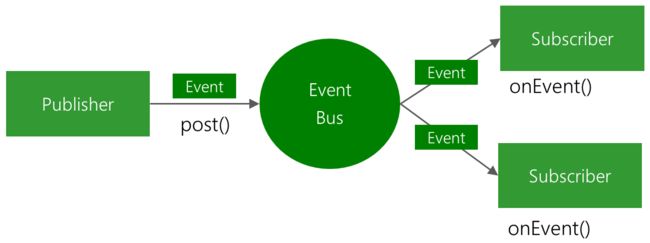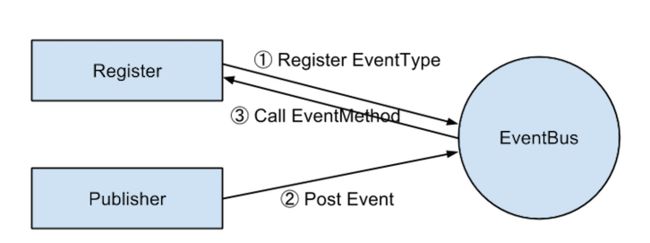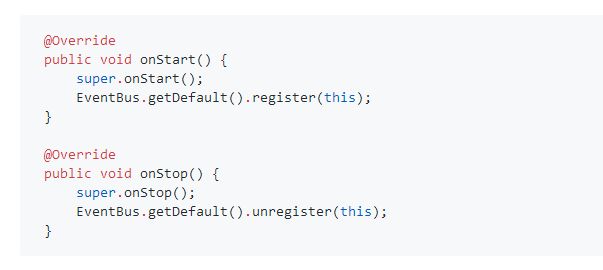EventBus(发布订阅事件总线):通过解耦发布者和订阅者简化android 事件传递
EventBus is a publish/subscribe event bus for Android and Java.
开源库地址:https://github.com/greenrobot/EventBus
一、EventBus 简介
1.简化了不同组件间(Activity,Fragment,Service) and 异步线程(Background Thread)与UI主线程间的通信
2.传统的事件(消息)传递方式有:Intent、接口回调、Handler、BroadcastReceiver ,
相比之下 EventBus 的优点:是代码简洁,使用简单,解耦事件的发布和订阅,更快,代码更小,50K 左右的 jar 包
3.结构关系图:EventBus 负责存储订阅者、事件相关信息,订阅者和发布者都只和 EventBus 关联,实现了事件发布和订阅的解耦
Events are posted ({@link #post(Object)}) to the bus, which delivers it to subscribers that have a matching handler method for the event type.
4.事件响应流程图:
订阅者首先调用 EventBus 的 register 接口订阅某种类型的事件,当发布者通过 post 接口发布该类型的事件时,EventBus 执行订阅者的事件响应函数。
二、基本概念:
1.事件(Event):其实就是一个Object对象,可以是String 类型,可以是一个自定义的Event对象,事件的分类:普通事件和黏性事件,EventType:表示事件所属的类
2.发布者(Publisher):发布某事件的对象 ,post(Object),postSticky(Object)
3.订阅者(Subscriber):订阅某种事件类型的对象,在事件响应函数中对事件进行处理
Event handling methods must be annotated by {@link Subscribe}, must be public, return nothing (void), and have exactly one parameter (the event).
三、如何使用
How to get started with EventBus in 3 steps
1.添加依赖库 compile'org.greenrobot:eventbus:3.1.1'
2.定义事件类型
3.声明订阅者事件响应方法:
Event handling methods must be annotated by {@link Subscribe}, must be public, return nothing (void), and have exactly one parameter
事件响应方法:必须:使用注解@Subscribe 声明 ,必须是public ,返回类型是void ,只有一个参数,Note that with EventBus 3 the method name can be chosen freely(EventBus3以后 方法名可以自定义)
4.注册、解注册事件: In Android, in activities and fragments you should usually register according to their life cycle.
Only while subscribers are registered, they will receive events.
5.Post events: Post an event from any part of your code. All currently registered subscribers matching the event type will receive it. 所有与事件类型相匹配的当前已注册的订阅者都可以收到事件
EventBus.getDefault().post(new MessageEvent("Hello everyone!"));
四、源码解析:
1. ThreadMode: http://greenrobot.org/eventbus/documentation/delivery-threads-threadmode/
线程模型:ThreadMode类是枚举类,在订阅者事件响应方法中,可以通过注解的方式设置线程模型,EventBus内置了4中线程模型,分别是ThreadMode.POSTING 、ThreadMode.MAIN、ThreadMode.BACKGROUND、ThreadMode.ASYNC
public enum ThreadMode {
POSTING,(默认的模式)
MAIN,
MAIN_ORDERED,
BACKGROUND,
ASYNC
}
(1). POSTING:事件在哪个线程发布出来的,事件处理函数就会在这个线程中运行——收发在同一个线程(由于发布事件方法可能运行在主线程,这意味着接收方法中不能执行耗时操作,否则会阻塞主线程)
(2).MAIN:不论事件是在哪个线程中发布出来的,该事件处理函数都会在UI线程中立即执行(这意味着接收事件方法不能执行耗时操作,否则会阻塞主线程;同时,由于是「立即」调用,所以发射事件方法此时是会被接收事件方法所阻塞的)
(3).MAIN_ORDERED: 接收事件方法会被放入 MessageQueue 中等待执行(这意味着发射事件方法是不会被阻塞的)
(4).BACKGROUND:如果事件是在UI线程中发布出来的,那么该事件处理函数就会在新的线程中运行,如果事件本来就是子线程中发布出来的,那么该事件处理函数直接在发布事件的线程中执行(不能执行UI更新操作)
(5).ASYNC:无论事件在哪个线程发布,该事件处理函数都会在新建的子线程中执行(不能执行UI更新操作)
2.黏性(Sticky )事件:当事件发布后,再有订阅者订阅该类型事件,依然能收到该类型事件最近一个 Sticky 事件。
3.Subscribe
线程模式,黏性事件,线程优先级
4.EventBus
register
unRegister
post
5.EventBusBuilder
参考文献:
http://a.codekk.com/detail/Android/Trinea/EventBus%20%E6%BA%90%E7%A0%81%E8%A7%A3%E6%9E%90
http://www.cnblogs.com/zhaoyanjun/p/6039221.html
https://github.com/greenrobot/EventBus




